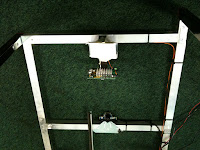Next is fitting the brake caliper. The forks I had were the silver Planet X ones which are much deeper that alloy forks where the brake caliper bolts on, this is not necessarily a problem as long as the 3 distances (A, B and C - see diagram) within the fork are sensible. The first problem I had was that C was way too long so the threads of the brake (purple) caliper bolt (green) would only engage enough for a couple of turns without the serrated washer (blue bit). I had a set of nuts (grey bits) of different lengths but a problem with C means this will not help. Ideally a setup like is pictured would be the best, where when tightened up shoulder of the nut is pressing on the forks (between A and B). If the nut is too long it's the end of the nut that will press on the forks (between B and C) which is not ideal. With my forks I had to drill them to make B longer (and C shorter), this was not a fun experience and took a lot of measuring and careful drilling to make sure B was the right length for the nut I was using and C was the right length for the bolt on the brake calipers. You need about 10mm of thread engagement between the bolt and nut, I was fitting Shimano Tiagra brakes and I think I used the standard nut that came with them. The length of B I don't think is critical and as long as you don't drill all the way through the forks it should be fine, you need to make sure the caliper bolt thread does not go too far through the nut otherwise you can't fit an allen key into the nut to tighten it up! If you're drilling you are best off marking the bit with tape and doing just a couple of mm at a time then test fitting to see how things are looking :).


















